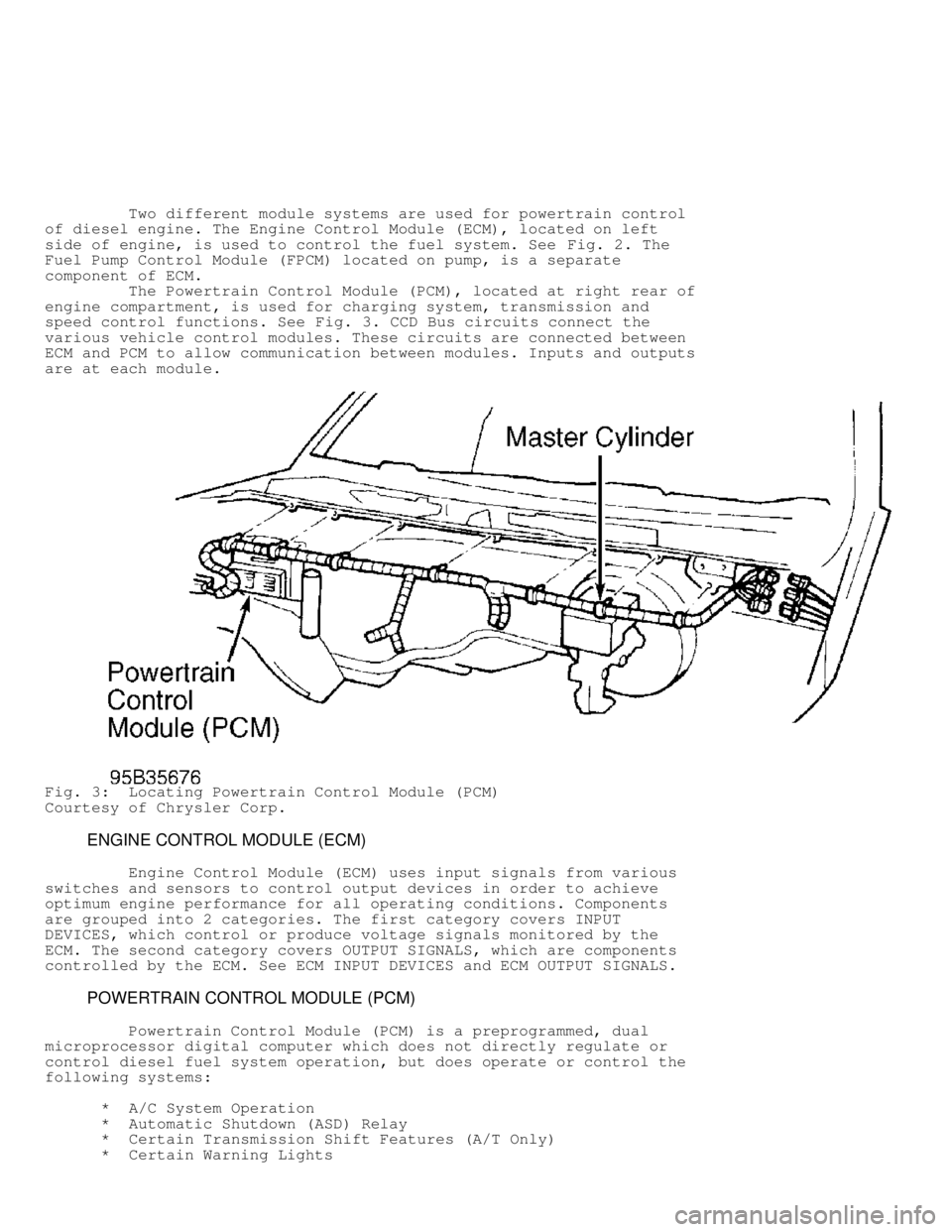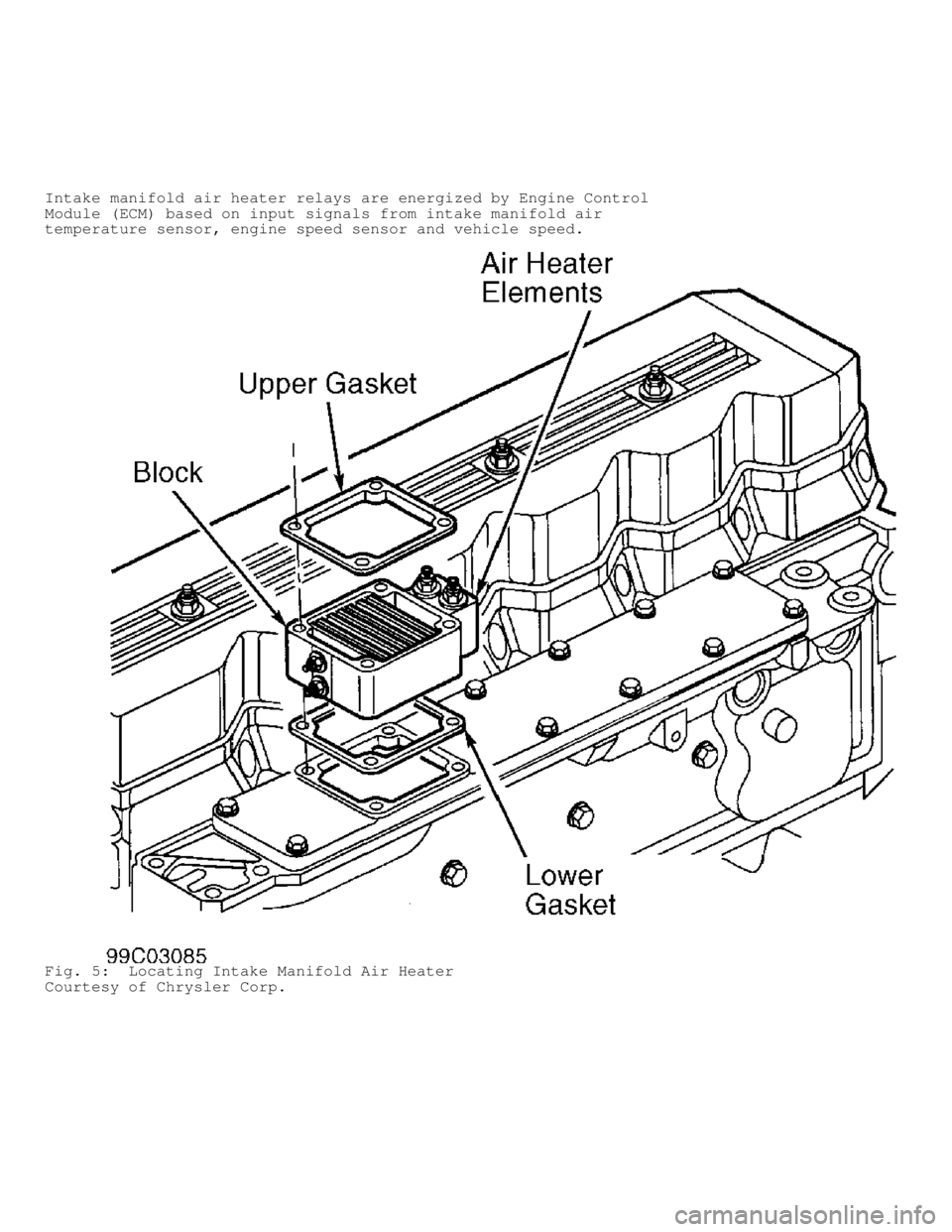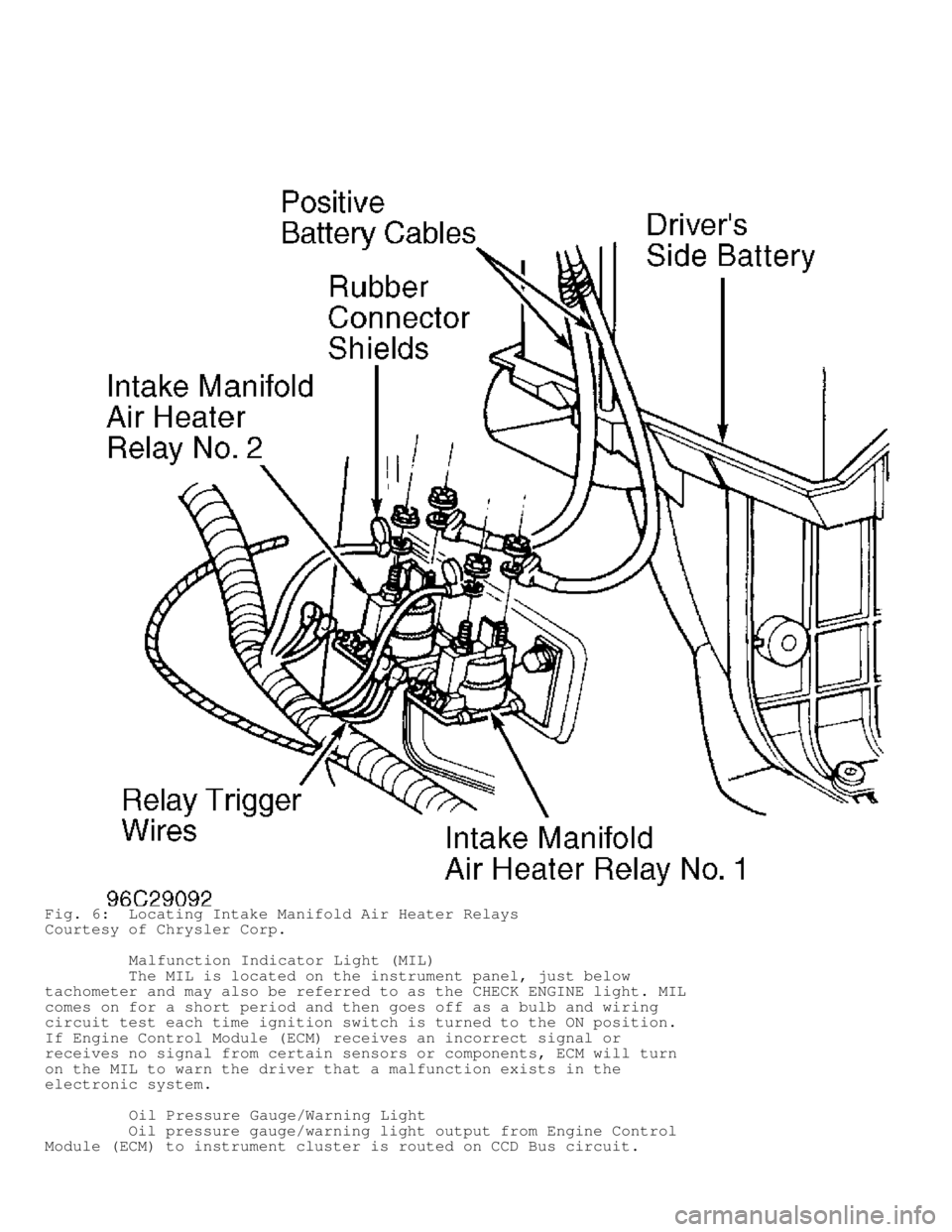relay DODGE RAM 1999 Service Repair Manual
[x] Cancel search | Manufacturer: DODGE, Model Year: 1999, Model line: RAM, Model: DODGE RAM 1999Pages: 1691, PDF Size: 40.34 MB
Page 1391 of 1691

TRUCKS & RWD VANS article.
Transmission Governor Pressure Sensor (A/T Models)
Transmission governor pressure sensor is located on
transmission valve body. If problem exists in transmission governor
pressure sensor or wiring circuit, a Diagnostic Trouble Code (DTC)
will be stored in Powertrain Control Module (PCM). See appropriate
governor pressure sensor test in SELF-DIAGNOSTICS - JEEP, TRUCKS & RWD
VANS article.
Transmission Overdrive Solenoid (A/T Models)
Transmission overdrive solenoid may also be referred to as
overdrive solenoid or 3-4 solenoid. Transmission overdrive solenoid is
located transmission valve body. If problem exists in transmission
overdrive solenoid or wiring circuit, a Diagnostic Trouble Code (DTC)
will be stored in Powertrain Control Module (PCM). See DTC P1740: TCC
OR O/D SOLENOID PERFORMANCE test in SELF-DIAGNOSTICS - JEEP, TRUCKS &
RWD VANS article.
Transmission Relay (A/T Models)
See RELAYS under RELAYS & SOLENOIDS.
Transmission Speed Sensor (A/T Models)
Transmission speed sensor may also be referred to as
transmission output shaft speed sensor. Transmission speed sensor is
located on overdrive case at rear of transmission. Transmission speed
sensor contains a 2-pin connector with a Dark Blue/Black wire and a
Light Green/Black wire. If problem exists in transmission speed sensor
or wiring circuit, a Diagnostic Trouble Code (DTC) will be stored in
Powertrain Control Module (PCM). See DTC P0720: LOW OUTPUT SPEED
SENSOR RPM, ABOVE 15 MPH test in SELF-DIAGNOSTICS - JEEP, TRUCKS & RWD
VANS article.
Transmission Temperature Sensor (A/T Models)
Transmission temperature sensor is incorporated into governor
pressure sensor on transmission valve body. If problem exists in
transmission temperature sensor or wiring circuit, a Diagnostic
Trouble Code (DTC) will be stored in Powertrain Control Module (PCM)\
.
See appropriate transmission temperature sensor test in SELF-
DIAGNOSTICS - JEEP, TRUCKS & RWD VANS article.
Transmission Torque Converter Clutch Solenoid (A/T Models)
The transmission Torque Converter Clutch (TCC) solenoid is
located on transmission valve body. If problem exists in TCC solenoid
or wiring circuit, a Diagnostic Trouble Code (DTC) will be stored in
Powertrain Control Module (PCM). See DTC P0743: TORQUE CONVERTER
CLUTCH SOLENOID/TRANSMISSION RELAY CIRCUIT test in SELF-DIAGNOSTICS -
JEEP, TRUCKS & RWD VANS article.
Page 1393 of 1691

Intake Air Temperature (IAT) Sensor
See appropriate DTC P0112: IAT SENSOR VOLTAGE LOW and DTC
P0113: IAT SENSOR VOLTAGE HIGH tests in SELF-DIAGNOSTICS - JEEP,
TRUCKS & RWD VANS article.
Manifold Absolute Pressure (MAP) Sensor
See appropriate DTC P0107: MAP SENSOR VOLTAGE TOO LOW and DTC
P0108: MAP SENSOR VOLTAGE TOO HIGH tests in SELF-DIAGNOSTICS - JEEP,
TRUCKS & RWD VANS article.
Transmission Temperature (TRANS Temp) Sensor
See appropriate DTC P0711: TRANSMISSION TEMPERATURE SENSOR,
NO TEMPERATURE RISE AFTER START, DTC P0712: TRANSMISSION TEMPERATURE
SENSOR VOLTAGE TOO LOW, and DTC P0713: TRANSMISSION TEMPERATURE SENSOR
VOLTAGE TOO HIGH tests in SELF-DIAGNOSTICS - JEEP, TRUCKS & RWD VANS
article.
Throttle Position (TP) Sensor
See appropriate DTC P0122: THROTTLE POSITION SENSOR VOLTAGE
LOW and DTC P0123: THROTTLE POSITION SENSOR VOLTAGE HIGH tests in
SELF-DIAGNOSTICS - JEEP, TRUCKS & RWD VANS article.
Vehicle Speed Sensor (VSS)
See appropriate DTC P0500: NO VEHICLE SPEED SENSOR SIGNAL
test in SELF-DIAGNOSTICS - JEEP, TRUCKS & RWD VANS article.
SOLENOIDS
Evaporative (EVAP) Purge Solenoid
See appropriate DTC P0443: EVAP PURGE SOLENOID CIRCUIT test
in SELF-DIAGNOSTICS - JEEP, TRUCKS & RWD VANS article.
Leak Detection Pump (LDP) Solenoid
See appropriate DTC P1495: LEAK DETECTION PUMP SOLENOID
CIRCUIT test in SELF-DIAGNOSTICS - JEEP, TRUCKS & RWD VANS article.
Speed Control (S/C) Solenoid
See appropriate DTC P1595: SPEED CONTROL SOLENOID CIRCUITS
test in SELF-DIAGNOSTICS - JEEP, TRUCKS & RWD VANS article.
Transmission Governor Pressure Solenoid
See appropriate DTC P0748: GOVERNOR PRESSURE
SOLENOID/TRANSMISSION RELAY CIRCUITS test in SELF-DIAGNOSTICS - JEEP,
TRUCKS & RWD VANS article.
Transmission 3-4 Solenoid
See appropriate DTC P0783: TRANSMISSION 3-4 SHIFT SOLENOID,
NO RPM DROP AT 3-4 SHIFT test in SELF-DIAGNOSTICS - JEEP, TRUCKS & RWD
VANS article.
SWITCHES
Leak Detection Pump (LDP) Switch
See appropriate DTC P1494: LEAK DETECTION PUMP SWITCH OR
MECHANICAL FAULT test in SELF-DIAGNOSTICS - JEEP, TRUCKS & RWD VANS
article.
Park/Neutral (P/N) Switch
See appropriate DTC P1899: PARK/NEUTRAL SWITCH STUCK IN PARK
OR IN GEAR test in SELF-DIAGNOSTICS - JEEP, TRUCKS & RWD VANS article.
Power Steering (PS) Switch
See appropriate DTC P0551: POWER STEERING SWITCH FAILURE test
Page 1394 of 1691

in SELF-DIAGNOSTICS - JEEP, TRUCKS & RWD VANS article.
Speed Control Switch
See appropriate DTC P1596: SPEED CONTROL SWITCH ALWAYS HIGH
and DTC P1597: SPEED CONTROL SWITCH ALWAYS LOW tests in SELF-
DIAGNOSTICS - JEEP, TRUCKS & RWD VANS article.
RELAYS
A/C Clutch Relay
See appropriate DTC P0645: A/C CLUTCH RELAY CIRCUIT test in
SELF-DIAGNOSTICS - JEEP, TRUCKS & RWD VANS article.
Auto Shutdown (ASD) Relay
See appropriate DTC P1388: AUTO SHUTDOWN RELAY CONTROL
CIRCUIT test in SELF-DIAGNOSTICS - JEEP, TRUCKS & RWD VANS article.
Fuel Pump Relay
See appropriate DTC P1282: FUEL PUMP RELAY CONTROL CIRCUIT
test in SELF-DIAGNOSTICS - JEEP, TRUCKS & RWD VANS article.
Radiator Fan Control Relay
See appropriate DTC P1491: RADIATOR FAN CONTROL RELAY CIRCUIT
test in SELF-DIAGNOSTICS - JEEP, TRUCKS & RWD VANS article.
Torque Converter Clutch (TCC) Relay
See appropriate DTC P0743: TORQUE CONVERTER CLUTCH
SOLENOID/TRANSMISSION RELAY CIRCUIT test in SELF-DIAGNOSTICS - JEEP,
TRUCKS & RWD VANS article.
Transmission Governor Pressure Solenoid Relay
See appropriate DTC P0748: GOVERNOR PRESSURE
SOLENOID/TRANSMISSION RELAY CIRCUIT test in SELF-DIAGNOSTICS - JEEP,
TRUCKS & RWD VANS article.
Transmission 12-Volt Supply Relay
See appropriate DTC P1765: TRANSMISSION 12-VOLT SUPPLY RELAY
CONTROL CIRCUIT test in SELF-DIAGNOSTICS - JEEP, TRUCKS & RWD VANS
article.
Vehicle Speed Control Relay
See appropriate DTC P1683: SPEED CONTROL POWER RELAY CIRCUIT
test in SELF-DIAGNOSTICS - JEEP, TRUCKS & RWD VANS article.
FUEL SYSTEM
FUEL DELIVERY
NOTE: For fuel system pressure testing, see BASIC DIAGNOSTIC
PROCEDURES - TRUCKS & RWD VANS - GASOLINE article.
FUEL CONTROL
Fuel Injector
See appropriate injector control circuit test in SELF-
DIAGNOSTICS - JEEP, TRUCKS & RWD VANS article.
IDLE CONTROL SYSTEM
IDLE AIR CONTROL (IAC) MOTOR
Page 1396 of 1691

article.
POSITIVE CRANKCASE VENTILATION (PCV)
PCV Valve
1) With engine running at curb idle, remove PCV valve from
grommet. If valve is functioning properly, a hissing sound will be
heard as air passes through valve.
2) With engine running, place finger over valve inlet. Strong
vacuum should be felt at valve inlet. Stop engine. Remove and shake
PCV valve to ensure a metallic clicking noise can be heard, indicating
valve is free. Reinstall PCV valve.
3) Remove crankcase ventilation filter or oil filler cap from
valve cover. Hold a piece of stiff paper over opening. After allowing
about one minute for crankcase pressure stabilization, paper should be
drawn against opening.
4) If paper is held against opening, performance is okay. If
paper is not held against opening, replace PCV valve and retest. If
performance does not improve, inspect system for restrictions and
clean as necessary.
MISCELLANEOUS CONTROLS
NOTE: Although the controlled devices listed here are not
technically engine performance components, they can affect
driveability if they malfunction.
RELAYS
A/C Clutch Relay
See A/C CLUTCH RELAY under RELAYS.
Radiator Fan Control Relay
See RADIATOR FAN CONTROL RELAY under RELAYS.
Torque Converter Clutch (TCC) Relay
See TORQUE CONVERTER CLUTCH (TCC) RELAY under RELAYS
Transmission Governor Pressure Solenoid Relay
See TRANSMISSION GOVERNOR PRESSURE SOLENOID RELAY under
RELAYS.
Transmission 12-Volt Supply Relay
See TRANSMISSION 12-VOLT SUPPLY RELAY under RELAYS.
Vehicle Speed Control Relay
See VEHICLE SPEED CONTROL RELAY under RELAYS.
Page 1461 of 1691

Two different module systems are used for powertrain control
of diesel engine. The Engine Control Module (ECM), located on left
side of engine, is used to control the fuel system. See Fig. 2. The
Fuel Pump Control Module (FPCM) located on pump, is a separate
component of ECM.
The Powertrain Control Module (PCM), located at right rear of\
engine compartment, is used for charging system, transmission and
speed control functions. See Fig. 3. CCD Bus circuits connect the
various vehicle control modules. These circuits are connected between
ECM and PCM to allow communication between modules. Inputs and outputs
are at each module.
Fig. 3: Locating Powertrain Control Module (PCM)
Courtesy of Chrysler Corp.
ENGINE CONTROL MODULE (ECM)
Engine Control Module (ECM) uses input signals from various
switches and sensors to control output devices in order to achieve
optimum engine performance for all operating conditions. Components
are grouped into 2 categories. The first category covers INPUT
DEVICES, which control or produce voltage signals monitored by the
ECM. The second category covers OUTPUT SIGNALS, which are components
controlled by the ECM. See ECM INPUT DEVICES and ECM OUTPUT SIGNALS.
POWERTRAIN CONTROL MODULE (PCM)
Powertrain Control Module (PCM) is a preprogrammed, dual
microprocessor digital computer which does not directly regulate or
control diesel fuel system operation, but does operate or control the
following systems:
* A/C System Operation
* Automatic Shutdown (ASD) Relay
* Certain Transmission Shift Features (A/T Only)
* Certain Warning Lights
Page 1464 of 1691

manifold, sends input signal to Engine Control Module (ECM). ECM uses
input signal for controlling fuel control, timing and engine
protection. ECM will lower engine power if boost is too high.
Oil Pressure Sensor
Oil pressure sensor signal is input to Engine Control Module
(ECM). ECM converts signal to pressure value. Value is sent on CCD Bus\
to instrument panel gauge/light. Oil pressure sensor is located on
side of engine block, below ECM. See Fig. 2.
Power Take Off (PTO)
This input is used on vehicles equipped with a Power Take Off
(PTO) unit. When PTO is engaged, Engine Control Module (ECM) will
disable some OBD-II functions.
Water-In-Fuel (WIF) Sensor
WIF sensor is located in bottom of fuel filter/water
separator. See Fig. 2. WIF sensor delivers input signal to Engine
Control Module (ECM) when water exists in the fuel filter/water
separator. As water level increases, resistance across WIF sensor
decreases. ECM compares decrease in resistance to a high water
standard value. When resistance is 30,000-40,000 ohms, ECM will turn
on WATER-IN-FUEL warning light. WATER-IN-FUEL warning light is located
on instrument panel, just below tachometer. ECM monitors input signal
when ignition switch is in the ON position and continues to monitor
input signal until intake manifold air heater post-heat cycle is
complete.
PCM INPUT SIGNALS
A/C Switch
When A/C switch is in ON position, an input signal is
delivered from A/C switch to Engine Control Module (ECM) to indicate
that A/C operation has been requested. Once A/C operation has been
requested, an A/C request signal is delivered to ECM from A/C high-
pressure switch and A/C low-pressure switch. The A/C request signal
indicates evaporator pressure is within proper range for A/C
operation. ECM uses A/C request signal to cycle A/C compressor clutch
by using an A/C clutch relay. A/C clutch relay may also be referred to
as A/C compressor clutch relay. If A/C high-pressure switch or A/C
low-pressure switch opens, A/C request signal will not be delivered to
the ECM. ECM will then open ground circuit for A/C clutch relay and
A/C compressor clutch will be disengaged.
The A/C clutch relay is located in power distribution center
at driver's side front corner of engine compartment, near the battery.
The A/C high-pressure switch is located on discharge line, near A/C
compressor. The A/C low-pressure switch is located on top of
accumulator.
Accelerator Pedal Position Sensor (APPS) Output From ECM
Accelerator Pedal Position Sensor (APPS) is mounted on top
left of engine. See Fig. 2. Sensor provides DC voltage input signal to
Engine Control Module (ECM) to indicate throttle position. On previous\
engines, there were linkages between accelerator pedal, throttle
position sensor and injection pump. On this engine, no linkage exists
between accelerator pedal and injection pump. APPS signal is sent on
CCD Bus circuit from ECM to PCM.
Automatic Shutdown (ASD) Relay
A 12-volt input signal is delivered from ASD relay to Engine
Control Module (ECM) when ASD relay is energized. If ECM does not
receive a 12-volt input signal when ASD relay is energized, a
Diagnostic Trouble Code (FTC) will be stored in ECM. ASD relay is
Page 1465 of 1691

located in power distribution center at driver's side front corner of
engine compartment, near the battery. Automatic Shutdown (ASD) relay
may also be referred to as Auto Shutdown (ASD) relay.
Battery Temperature Sensor
Battery temperature sensor delivers input signal to
Powertrain Control Module (PCM) to indicate the battery temperature.
PCM uses battery temperature input to modify rate of output from the
charging system. Battery temperature sensor is snapped into battery
tray below driver's side battery.
Battery Voltage
Battery voltage input signal provides operating voltage to
Powertrain Control Module (PCM). This input signal keeps PCM memory
alive and informs PCM what generator output voltage is when engine is
running. PCM memory is used to store Diagnostic Trouble Codes (DTCs),
store APPS sensor voltages from previous key cycles and provide a
speed control adaptive memory.
Brake Switch
Brake switch delivers input signal to Powertrain Control
Module (PCM) to indicate when brakes are applied. PCM uses input
signal for controlling cruise control system and transmission torque
converter clutch operation on A/T models. Brake switch is located near
top of brake pedal and may also be referred to as brakelight switch.
CKP Sensor
Crankshaft Position (CKP) sensor delivers input signal (35
tooth wheel with gap) to Engine Control Module (ECM) to indicate
engine speed and crankshaft position. ECM uses CKP signal along with
other input signals for controlling injector firing sequence and
timing. Sensor is located below fuel transfer pump, on side of engine
block. See Fig. 2.
Cruise Control System Switches
Cruise control system functions, controlled by momentary
contact switches, are monitored through multiplexed input signal to
Powertrain Control Module (PCM). Resistance monitored at this input
signal, in conjunction with the length of time the PCM measures the
resistance, determines which switch feature has been selected.
Data Link Connector (DLC)
Data Link Connector (DLC) provides an input signal to
Powertrain Control Module (PCM) when using scan tool to retrieve
Diagnostic Trouble Codes (DTCs) from PCM. Input signal may also be
used when performing various tests on the PCM and electronic control
system. DLC is a 16-pin connector located at lower edge of driver's
side of instrument panel, just above accelerator pedal.
Fuel Level Sensor
The Powertrain Control Module (PCM) sends a 5-volt signal to
the fuel level sensor. The fuel level sensor will return a signal to
PCM. This signal is used for fuel gauge operation and to prevent
setting a false misfire or fuel system trouble codes. If fuel level is
less than 15 percent, PCM will not set code.
Ignition Sense
Ignition switch position input to Powertrain Control Module
(PCM). PCM uses input to determine proper output functions, including
cruise control, generator output, sensor supply and transmission
functions.
Transmission Speed Sensor (A/T Models)
Page 1467 of 1691

brakelines are attached to and is mounted in the engine compartment.
ECM OUTPUT SIGNALS
APPS & CKP Output To PCM
See ACCELERATOR PEDAL POSITION SENSOR (APPS) OUTPUT FROM ECM
under PCM INPUT SIGNALS.
CCD Bus
These circuits are connected between Engine Control Module
(ECM) and Powertrain Control Module (PCM) to allow communication
between modules.
DLC Output
Data Link Connector (DLC) is connected to Engine Control
Module (ECM). Using a scan tool, data can be retrieved (output) from\
ECM.
5-Volt Sensor Supply Output
Engine Control Module (ECM) supplies a 5-volt reference
signal to the following sensors:
* Crankshaft Position (CKP) Sensor
* Camshaft Position (CMP) Sensor
* Intake Air Temperature (IAT) Sensor
* Engine Oil Pressure Sensor
* Manifold Absolute Pressure (MAP) Sensor
Engine Control Module (ECM) also supplies voltage to the
following sensors:
* Accelerator Pedal Position Sensor (APPS)
* Intake Air Temperature (IAT) Sensor
* Engine Oil Pressure Sensor
* Engine Coolant Temperature (ECT) Sensor
* Manifold Absolute Pressure (MAP) Sensor
* Water-In-Fuel (WIF) Sensor
Fuel Injection Pump Relay
The Engine Control Module (ECM) energizes the fuel injection
pump and integral Fuel Pump Control Module (FPCM) through the relay.
When ignition is turned on, ECM supplies 12 volts to fuel injection
pump relay, located in Power Distribution Center.
Fuel Pump Control Module (FPCM)
Fuel Pump Control Module (FPCM) controls fuel pump using
inputs from Engine Control Module (ECM). FPCM is integral to top of
fuel pump. ECM and FPCM are interconnected together for fuel injection
control.
Fuel Transfer Pump
Engine Control Module (ECM) supplies power to fuel transfer
pump. Transfer fuel pump supplies fuel under low pressure (14 psi)
while engine is running to fuel injection pump. Fuel transfer pump
supplies an excess of fuel to cool fuel injection pump. Excess fuel is
returned to fuel tank by fuel injection pump.
Intake Manifold Air Heater Relays
Intake manifold air heater relays provide voltage to intake
manifold air heater for warming of intake. See Fig. 5. Warming of
intake air aids in engine starting and improved driveability during
cold ambient temperatures. Intake manifold air heater relays are
mounted on inner wheelwell, below driver's side battery. See Fig. 6.
Page 1468 of 1691

Intake manifold air heater relays are energized by Engine Control
Module (ECM) based on input signals from intake manifold air
temperature sensor, engine speed sensor and vehicle speed.
Fig. 5: Locating Intake Manifold Air Heater
Courtesy of Chrysler Corp.
Page 1469 of 1691

Fig. 6: Locating Intake Manifold Air Heater Relays
Courtesy of Chrysler Corp.
Malfunction Indicator Light (MIL)
The MIL is located on the instrument panel, just below
tachometer and may also be referred to as the CHECK ENGINE light. MIL
comes on for a short period and then goes off as a bulb and wiring
circuit test each time ignition switch is turned to the ON position.
If Engine Control Module (ECM) receives an incorrect signal or
receives no signal from certain sensors or components, ECM will turn
on the MIL to warn the driver that a malfunction exists in the
electronic system.
Oil Pressure Gauge/Warning Light
Oil pressure gauge/warning light output from Engine Control
Module (ECM) to instrument cluster is routed on CCD Bus circuit.